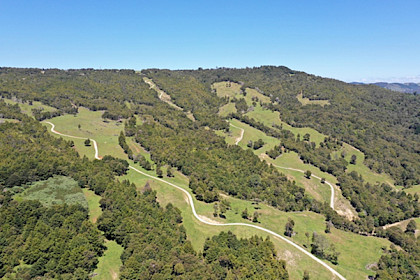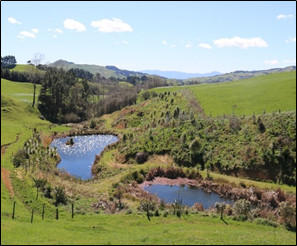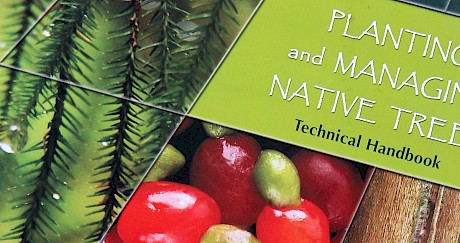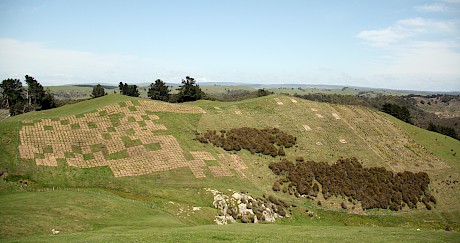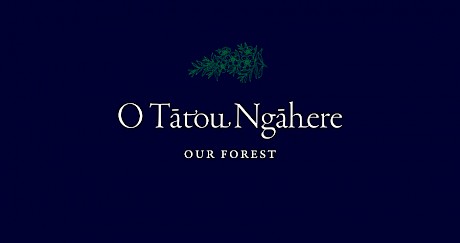Normalising Native ForestryProject Status: Current
Introduction
The second year of the three-year Normalising Native Forestry Programme (NNF), supported by The Tindall Foundation (TTF) and managed by Tāne’s Tree Trust (TTT), has been completed. The aim of this three-year research programme is to continue developing and providing the urgently needed tools, resources, and advice to support native forestation at scale in Aotearoa.
Background
The programme of applied research and technology transfer addresses the urgent need for science-based information and technical advice for establishing native forest at scale to address climate change and environmental degradation. It focuses on working with nature, demonstrating managed regeneration to cost-effectively establish native forest at scale, and providing options for sustainable management of nature-based native forestry.
Research, collaboration and information sharing has continued across six workstreams during Year 2.
1. Working with Nature - native forestation at landscape scale
The Climate Change Commission recommended a major upscaling of native forestation efforts, nearly 300,000 ha of new native forests within the next 15 years. With the cost of planting often at $20,000 per hectare, cost-effective establishment at scale requires working with nature by encouraging natural regeneration as well as planting. Progress with projects within this workstream during Year 2 has included:
- Seed island demonstration sites – A co-funded project has been developed with Trees That Count, supported by Z Energy, to run for the next three years to set up seed island demonstration areas across five regions, along with various satellite sites from Northland to Southland aimed at promoting natural regeneration combined with pest browsing animal, bird and seed predator, and selective exotic weed control.
- Working with nature – Contributing to the debate with policy makers promoting regeneration as a realistic option for establishing native forest at scale across marginal hill country, as part of submissions supporting the Climate Change Commission and the Ministerial Inquiry on land use in Tairāwhiti. This includes promoting a mosaic of land uses that includes integrating native forestry and exotic production forestry on appropriate sites with agricultural and horticultural land uses.
- Measuring success – The TTT Monitoring system for planted native forest is completed and will be launched in late 2023. Project partners include Trees That Count, Auckland Council, Tasman Environmental Trust and Pāmu Farms, in collaboration with iwi, landowners, environmental NGOs and community groups. Four videos on monitoring are almost complete with support from the DOC Community Conservation Fund and TTF co-funding from the NNF programme.
- Videos and factsheets on best practice – Ongoing NNF co-funding support from Department of Conservation and Te Uru Rakau on promoting best-practice establishment and management of native forest for environmental and production purposes with the series of new factsheets to be launched in late 2023 and further release of practical ‘how to’ videos.
2. Promoting Nature-based indigenous forestry in Aotearoa
We are well positioned to develop nature-based forestry in NZ, with a good track record already with tōtara (Northland) and beech (Westland). NZ currently imports about $100 million per year in specialty timbers, some of which could be substituted with sustainably grown native timbers.
This workstream continues from the “Building on the Northland tōtara work” work completed during the Our Forests Our Future programme. It is intended to promote the development of nature-based forestry to establish and manage long-term sustainable native forest resources for multiple benefits. This has included:
- Promoting sustainable native forest management on private land – for multiple benefits and values.
- Legal impediments – Work on resolving the legal and regulatory impediments and disincentives to sustainable native forestry.
- Northland Tōtara Working Group – Convene the NTWG and support the next phase development of the Tōtara Industry Pilot (TIP) project.
- Technology transfer – Continue to develop and provide advice to landowners, NTWG newsletters, hold field days, and give workshop and conference presentations, and technical resources via our website.
- Research topics – Continue to scope/prepare bids for funded research on native forest management.
- Sustainable management of other forest types – Promote nature-based forestry systems for tōtara and other species nationwide including sustainable specialty timber production using CCF of both planted and regenerating forest, e.g., beech in the South Island.
- Collaboration – Networking and information exchange with overseas groups such as Pro Silva.
- Servicing – Requests for information related to native forestry matters.
Highlights of this year’s accomplishments include:
- Successful application to MPI for a funded project on business models for Continuous Cover Forestry (CCF) in NZ – TTT as a collaboration partner with The Connective, Ngā Pou a Tāne, and SCION.
- Co-organised a series of six online 1.5hr wananga (workshops) on CCF with expert speakers and around 70 invited participants.
- Field visits with Rt. Hon. Minister James Shaw, Parliamentary Commissioner for The Environment team, and a training day for the Northland Regional Council land manager team, at a Northland tōtara project property.
- Preparation of a SFM Plan application at Pāmu’s Weka Station property near Moana (Lake Brunner).
- Production of the Northland Tōtara Working Group newsletter 2023.
- Submissions on the National Policy Statement for Indigenous Biodiversity, Far Inquiry North District Plan, and input into TTT’s submission on the Ministerial Inquiry into Land use in Tairāwhiti.
- Planned a spray screening trial over tōtara seedlings for the herbicide Haloxyfop.
3. Making the most of Tāne’s Tree Trust’s databases
Tāne’s Tree Trust has the most comprehensive national database for planted native forests, which has been used to develop models and calculators. This database and associated tools are providing essential data for policy-makers, investors, and the forestry and farming sectors. Projects underway and progress during Year 2 include:
- TTT Plantation Database – Restructuring of the Tāne’s Tree Trust plantation database is continuing to convert this from an Excel spreadsheet system into a purpose-built relational database in Microsoft Access. The database is being designed to include data from managed regenerating farm stands and transition pine to native forestry projects underway.
- Survey of native plantings – The national survey of indigenous plantations is set up and awaits a major co-funder for a three-year period to start the survey of an anticipated minimum of 150 stands, ranging in age from five to 110 years old located nationwide. Permanent Sample Plots will be established in at least 50 new sites when surveying begins.
- TTT native forestry toolkit – The TTT toolkit, comprising calculators for Planting and Budgeting, Growth and Yield, Carbon, and Economics was launched in time for the O Tātou Ngāhere National Conference on native forestry at Te Papa, co-funded by MPI’s Sustainable Farming Fund and TTF.
- TTT monitoring tool for planted natives – Co-funded project completed, with an online app for assessing early survival and growth of planted natives, which is user friendly, now available on the TTT website.
4. Incentivising landowners – an economic case for native forestation 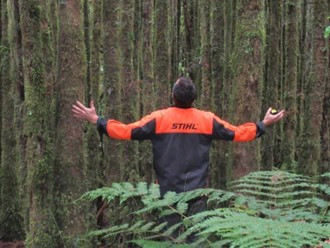
The cost of planting natives remains a limiting factor for landowners. The business case for native forestation, therefore, relies on decreasing the costs, and also compensating landowners for the non-timber values that accrue to the wider community, but do not currently have a market value. The Climate Change Commission’s advice to Government includes creation of incentives for establishing native forest. Progress on various initiatives during Year 2 included:
- Valuing native ecosystems on farms – A multi-agency $1 million programme, led by Pāmu Farms, is underway with the first year focused on two Northland stations with areas of wetland, freshwater and native forest stands that are in various states of restoration. The aim is to assess the relative quality and ecosystem service values before and after restoration efforts, using a valuation framework unique to NZ. A web-based tool will ultimately be created for landowners to help them make their own assessments.
- Recognising non-timber values – The recently launched TTT toolkit includes multiple non-timber benefits that users can enter for their project. This will provide further impetus for developing a biodiversity incentives system for restoration and management of native ecosystems across working landscapes.
- TTT economics calculator – As part of the toolkit on establishment of natives, the cost and benefits of planting and managing natives for multiple objectives, including the long term option of specialty timber production from appropriate sites, is completed and available on the TTT website.
- Carbon sequestration – Ongoing collaboration with Pure Advantage in quantifying and comparing carbon sequestration for a range of planted and regenerating native forestry scenarios as an option for offsetting NZ’s greenhouse gas emissions and reducing reliance on offshore carbon credits.
- Presentations made to various industry and community groups on the wider values of native forest, plus advocacy for landowner incentives for establishing and managing native forest.
- Multiple submissions have been made, including to MPI for the Pricing Agricultural Emissions consultation, to the Climate Commission’s advice on the second Emissions Reduction Plan, and to MfE/MPI on the Permanent Forest Category in the ETS.
- Ongoing involvement in stakeholder consultation workshops with government on potential development of a biodiversity credits incentives scheme, which went out for public consultation in July.
- Conference presentation on Investing in Natural Capital - Weaving native forest back through NZ’s landscape, for the trans-Tasman 2023 Australia & NZ Institute of Forestry Conference - Embracing Our Natural Capital.
5. Evaluating novel ecosystems - transitioning exotics to natives 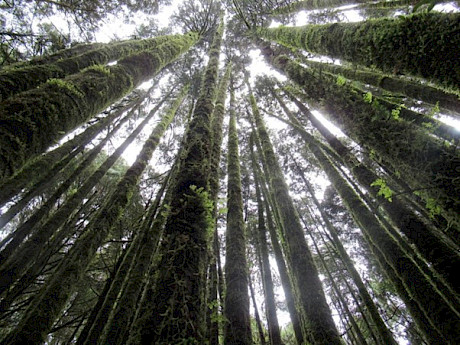
Exotic woody plants that dominate many of our landscapes can potentially be transitioned to native forest. Carbon forestry interests are currently investing in permanent carbon forests, capitalising on the fast early growth of radiata pine, then leaving it as a nurse for permanent native forest. It is important to understand the factors that affect native regeneration and natural succession under exotic species and also how we can weave more native forest into our landscapes and what new forms that may take. This year the workstream has involved:
- Contact with various stakeholders in the transitional forestry sector.
- Supporting the SFFF Transitional Forestry project (see project report by Meg Graeme).
- Input to TTT submission on the Permanent Forest category of the NZ Emissions Trading Scheme.
- Exploring further potential research projects on novel ecosystems and transitional forestry.
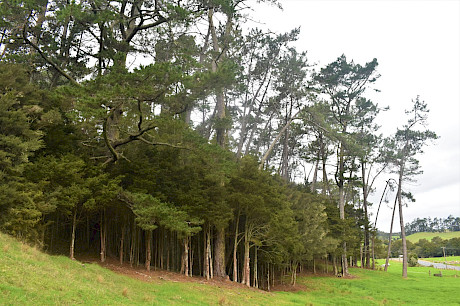 6. Collaboratively building capability
6. Collaboratively building capability
A holistic, multi-agency approach is required for native forest to be successfully established at scale. Working with other entities to tackle herbivory, bird and seed predation, and control of vigorous weeds is a priority. Collaboration underway included:
- Partnerships in restoration of native forest – Collaboration with Trees That Count, Z Energy, Pāmu Farms, NZ Arboricultural Association, Longbush Ecological Trust, Pro Silva Continuous Cover Forestry, Te Kohaka o Tuhaitara Trust and Kaipara Moana Remediation Project to jointly promote restoration of native forest for multiple purposes, integrated with pest weed and animal control, supplementary planting and bird predator control programmes.
- Workshops and technology transfer to iwi, landowners, managers – Organising and contributing workshops and field-based events across iwi and farming and forestry sectors and for land managing agencies, both private and public, requesting latest best-practice guidelines on native forestry establishment and management to meet multiple objectives.
- National Fieldays – Participation in the National Fieldays at Mystery Creek in November 2022 and June 2023 as part of the TUR/MPI Forestry Hub with 40 forestry entities including NZ Farm Forestry, NZ Forest Owners, Forest Growers Research, Scion, forest biosecurity, native and exotic forestry consultants, native plant nurseries, Toi Ohomai Institute of Technology, wood processors, etc.
- NZ Institute of Forestry – Dr Jacqui Aimers, TTT trustee, elected as council member of the NZ Institute of Forestry, providing technical advice on native forest management and promoting collaboration between NZIF and the wider forestry sector and TTT.
- Two professional training sessions were provided for NZ Institute of Forestry members on various aspects of native forest establishment and management.
- Assisted Parliamentary Commission for the Environment with their investigation on native forestry, including organising field trips to Cassie’s Farm, Adam Thompson’s Restore Native Nursery, and the Northland farm-tōtara work.
- MPI/TUR collaboration – Various initiatives are underway to collaborate with the Ministry of Primary Industries and Te Uru Rakau farming and forestry teams, in supporting farm and forestry advisors with professional development to upskill in the integration of native forestry with the wider farming and production forestry sector.
For more information on the Normalising Native Forestry Programme contact:
· TTT Office Enable JavaScript to view protected content.

